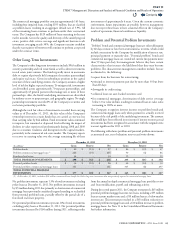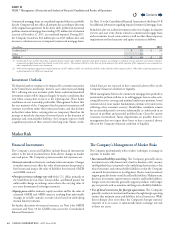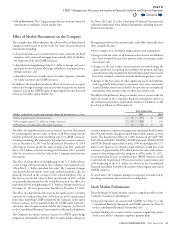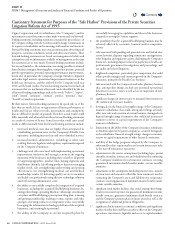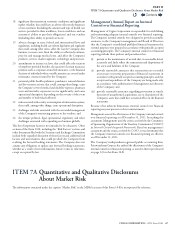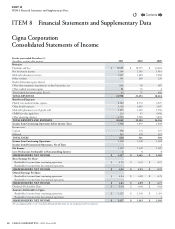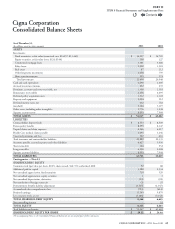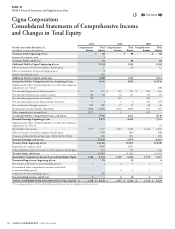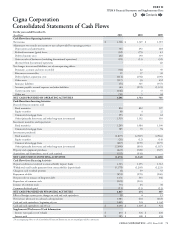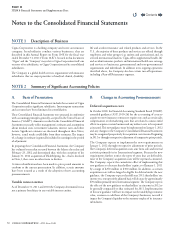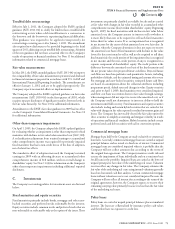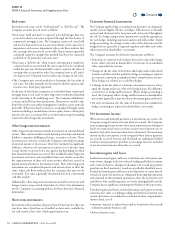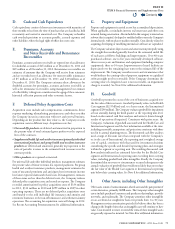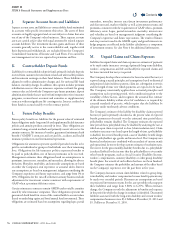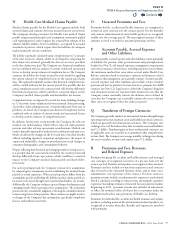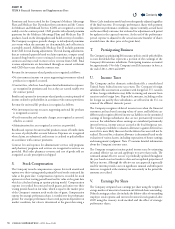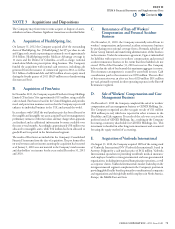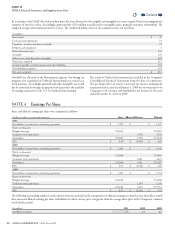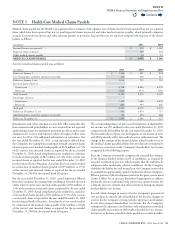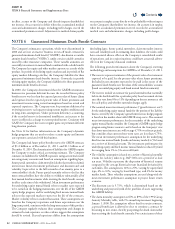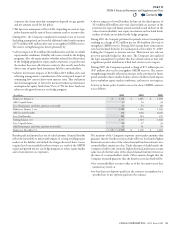Cigna 2011 Annual Report Download - page 95
Download and view the complete annual report
Please find page 95 of the 2011 Cigna annual report below. You can navigate through the pages in the report by either clicking on the pages listed below, or by using the keyword search tool below to find specific information within the annual report.
73CIGNA CORPORATION2011 Form10K
PART II
ITEM 8 Financial Statements and Supplementary Data
Troubled debt restructurings
Eective July1,2011, the Company adopted the FASB’s updated
guidance (ASU 2011-02) to clarify for lenders that a troubled debt
restructuring occurs when a debt modication is a concession to
the borrower and the borrower is experiencing nancial diculties.
This guidance was required to be applied retrospectively for
restructuringsoccurring on or after January1,2011. e amendment
also required new disclosures to be providedbeginning in thethird
quarter of 2011 addressing certain troubled debt restructurings. Adoption
of the new guidance did not have a material eect to the Company’s
results of operations or nancial condition. See Note11 for additional
information related to commercial mortgage loans.
Fair value measurements
In May2011, the FASB amended guidance (ASU2011-04) to improve
the comparability of fair value measurements presented and disclosed
in nancial statements prepared in accordance with U.S. GAAP and
International Financial Reporting Standards. e amendments are
eective January1,2012 and are to be applied prospectively.e
Company expects no material eects at implementation.
e Company adopted the FASB’s updated guidance on fair value
measurements (ASU 2010-06) in the rst quarter of 2010, which
requires separate disclosures of signicant transfers between levels in
the fair value hierarchy. See Note10 for additional information.
Amendments to the FASB’s fair value guidance in 2009 had no eect
on the Company’s Consolidated Financial Statements. See Note10
for additional information.
Other-than-temporary impairments
On April1,2009, the Company adopted the FASB’s updated guidance
for evaluating whether an impairment is other than temporary for xed
maturities with declines in fair value below amortized cost (ASC 320).
A reclassication adjustment from retained earnings to accumulated
other comprehensive income was required for previously impaired
xed maturities that had a non-credit loss as of the date of adoption,
net of related tax eects.
e cumulative eect of adoption increased the Company’s retained
earnings in 2009 with an osetting decrease to accumulated other
comprehensive income of $18million, with no overall change to
shareholders’ equity. See Note11 (A) for information on the Company’s
other-than-temporary impairments including additional required
disclosures.
C. Investments
e Company’s accounting policies for investment assets are discussed
below:
Fixed maturities and equity securities
Fixed maturities primarily include bonds, mortgage and other asset-
backed securities and preferred stocks redeemable by the investor.
Equity securities include common stocks and preferred stocks that are
non-redeemable or redeemable only at the option of the issuer. ese
investments are primarily classied as available for sale and are carried
at fair value with changes in fair value recorded in accumulated other
comprehensive income (loss) within shareholders’ equity. Beginning
April1,2009, for xed maturities with declines in fair value below
amortized cost, the Company assesses its intent to sell or whether it
is more likely than not to be required to sell such xed maturities
before their fair values recover. If so, an impairment loss is recognized
in net income for the excess of their amortized cost over fair value. In
addition, when the Company determines it does not expect to recover
the amortized cost basis of xed maturities with declines in fair value
(even if it does not intend to sell or will not be required to sell these
xed maturities), the credit portion of the impairment loss is recognized
in net income and the non-credit portion, if any, is recognized in a
separate component of shareholders’ equity. e credit portion is the
dierence between the amortized cost basis of the xed maturity and
the net present value of its projected future cash ows. Projected future
cash ows are based on qualitative and quantitative factors, including
probability of default, and the estimated timing and amount of recovery.
For mortgage and asset-backed securities, estimated future cash ows
are based on assumptions about the collateral attributes including
prepayment speeds, default rates and changes in value. Equity securities
and, prior to April1,2009, xed maturities were considered impaired,
and their cost basis was written down to fair value through earnings,
when management did not expect to recover the amortized cost, or if
the Company could not demonstrate its intent or ability to hold the
investment until full recovery. Fixed maturities and equity securities
also include trading and certain hybrid securities that are carried at fair
value with changes in fair value reported in realized investment gains and
losses. e Company has irrevocably elected the fair value option for
these securities to simplify accounting and mitigate volatility in results
of operations and nancial condition. Hybrid securities include certain
preferred stock and debt securities with call or conversion options.
Commercial mortgage loans
Mortgage loans held by the Company are made exclusively to commercial
borrowers. Generally, commercial mortgage loans are carried at unpaid
principal balances and are issued at a xed rate of interest. Commercial
mortgage loans are considered impaired when it is probable that the
Company will not collect amounts due according to the terms of
the original loan agreement. e Company monitors credit risk and
assesses the impairment of loans individually and on a consistent basis
for all loans in the portfolio. Impaired loans are carried at the lower of
unpaid principal or fair value of the underlying real estate. Valuation
reserves reect any changes in fair value. e Company estimates the
fair value of the underlying real estate using internal valuations generally
based on discounted cash ow analyses. Certain commercial mortgage
loans without valuation reserves are considered impaired because the
Company will not collect all interest due according to the terms of the
original agreements, however, the Company expects to recover their
remaining carrying value primarily because it is less than the fair value
of the underlying real estate.
Policy loans
Policy loans are carried at unpaid principal balances plus accumulated
interest. e loans are collateralized by insurance policy cash values
and therefore have no exposure to credit loss.
Contents
Q


